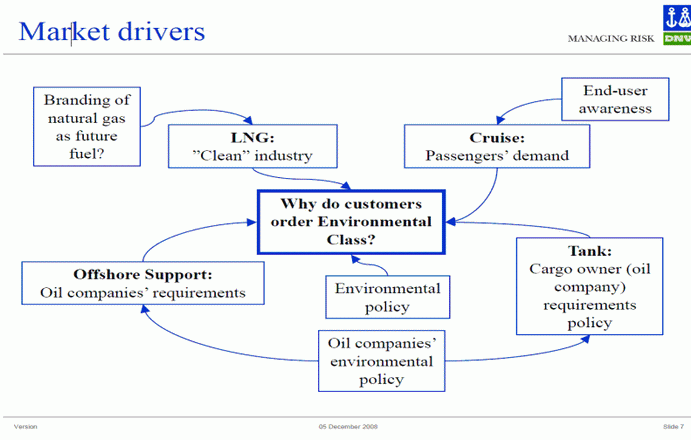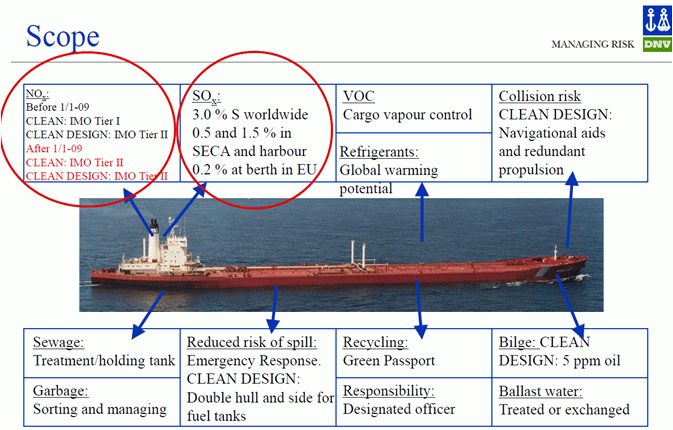|
At last, 5 ppm type approval certification for bilge water separators
5/17/2012 |
|
|
A new milestone in oily water treatment onboard ships has been reached. Shipowners seeking Clean Design class notation can now specify a bilge water treatment system that is certified according to DNV's new 5 ppm type approval process.
DNV Clean Design class notation is a voluntary newbuilding specification which covers most aspects of ship design and operation. For bilge water, Clean Design stipulates a maximum 5 ppm of oil remaining in the water after treatment, prior to pumping overboard. MARPOL regulations stipulate 15 ppm. In 2011, DNV introduced a 5 ppm type approval process for marine bilge water separators. Leading the wave, Alfa Laval's PureBilge is the first system to obtain the new 5 ppm DNV type approval certificate. The system has also been granted the US Coastguard Certificate of Approval.
Previously, ship owners specifying 5 ppm have had to take the word of the equipment supplier that the system really does meet the limit. Unfortunately, this has not always been enough. Some systems actually have problems reaching even 15 ppm under real life conditions.
While claiming that their equipment can meet the limit, it is not unknown for suppliers to simply adjust the oil-in-water monitor down from 15 ppm to 5 ppm so that it functions as an oily water alarm with automatic stop.
Recirculation, tanks fill up
In such cases, the equipment is not removing the oil down to 5 ppm. It simply prevents it from being discharged overboard. The bilge water then goes into recirculation and fills up the bilge water tank. When this is full it is pumped to the waste oil tank and when that has no more capacity the ship has a problem. It is in situations like these that environmental infringements may occur.
Type Approval certification
In May 2011, the DNV 5 ppm Type Approval Programme No. 771.60 became available for certification for Oily Water Separators (OWS) for the first time.
Alfa Laval's PureBilge system was tested according to this procedure and in December 2011 Alfa Laval obained Type Approval Certificate No. P-13965 for PureBilge 2005 and 5005 (2.5 m3/h and 5.0 m3/h).
For Alfa Laval this was not a great step. Since its release on the market in June 2009, PureBilge had been tested onboard ships under real life conditions and consistently achieved results below 5 ppm.
Clean and Clean Design notations
DNV Environmental Class notation reduces a ship's environmental impact due to air emissions, sea discharges and accidental damage to the ship's hull. The notations award owners and operators who choose to design and operate their ships in an evironmentally sustainable manner. The aim is to reduce the emissions from each ship so that the overall environmental burden from shipping is reduced.
DNV Clean notation stipulates that the vessel must be designed and operated in accordance with current and future regulations for protection of the environment. Technical and management processes and procedures for collection, transfer and storage of waste must also be adopted.
The Clean Design notation is based on the same Clean goals but is stricter. It stipulates that the constructional design and operation of vessels should be such that it minimizes their impact on the environment.
Why do ship owners want Environmental Class notation•
Clean and Clean Design class notations are voluntary environmental newbuilding specifications. As indicated in Fig. 1, an important driver is the oil majors' environmental policies, which are becoming increasingly stringent following a number of environmental disasters.
Fig. 1 - Slide 7 from DNV Clean Design presentation
As cargo owners and charterers, the oil companies typically demand higher than normal environmental compliance from the ship owners transporting their cargoes, such as tanker owners and owners of offshore supply vessels.
The same applies to owners building LNG carriers and car carriers and, to some extent, to cruise lines, as environmental awareness grows among passengers.
Clear benefits
DNV points out that the image of the individual ship owner and operator will clearly improve with customers and authorities, "since the notation demonstrates that the company's policy is to be environmentally proactive in order to prevent accidental pollution as well".
For owners interested in promoting an environmental profile, the notation confirms a higher environmental standard. By adopting the Clean Design notation, owners clearly demonstrate that they have acted to limit emissions and operational and accidental pollution by taking proactive steps and responsibility.
Aspects covered by Clean Design
The Clean Design notation stipulates requirements for controlling and limiting operational emissions and discharges. As Fig. 2 shows, these requirements cover the most important environmental aspects: Fuel tanks' protection from grounding damage; handling of sewage and garbage; environmentally friendly antifouling; combustion machinery emissions (NOx and SOx); use of refrigerants; Green Passport Inventory for recycling the ship; handling of ballast water; handling of fuel oil; handling of bilge water.
Fig. 2 - Slide 4 from DNV Clean Design presentation

As stated in DNV's "Guidance for the Environmental Class Notations Clean and Clean Design", "for Clean Design the vessel must have bilge water holding tanks as required for the Class Notation OPP-F, which means that they must have required capacities dependent on the engine rating. The machinery space bilges must not be discharged to sea, but be discharged to shore. Clean Design requires oil content of bilge water to be less than 5 ppm."
However, meeting DNV's Clean Design requirements for bilge water takes more than setting the oil-in-water monitor to 5 ppm. The treatment system must actually achieve 5 ppm.
Current MARPOL legislation stipulates that separated bilge water containing 15 ppm or below oil in water can be discharged into international waters. In reaction to increasing environmental awareness in the shipping and other industries, future legislation is expected to be more stringent, requiring the limit to be reduced to 5 ppm. For the Great Lakes it is already 5 ppm.
Since a growing number of shipowners are specifying it and DNV now has a 5 ppm type approval process for bilge water separators, a MARPOL 5 ppm limit may not be far away.
A new angle on OWS type approval testing
International Maritime Organization (IMO), resolution MEPC 107(49), effective from January 1, 2005, for type approval of bilge water separators for 15 ppm, specifies that, in addition to the removal of oil from bilge water, bilge water separators must be tested with a stable emulsion (including fine particles and a surfactant chemical).
What differentiates DNV 5 ppm type approval testing from type approval testing for 15 ppm according to MEPC 107(49)• Actually, very little. It is basically the same basic process with one very important difference. As stated by DNV, "the 5 ppm bilge water separator must be designed to operate in each plane that forms an angle of 22.5º with the plane of its normal operating position."
This simulates a ship listing 22.5º. Thus, this testing process has gone some way towards simulating real life operating conditions at sea. Although Alfa Laval believes that it could have gone even further and simulated sea heave, the company sees this as confirmation of its assertion that centrifugal separation is the only effective technology for bilge water treatment onboard ships.
"The gyroscopic effect of the liquid circulating at high speed inside the separator bowl offsets pitching and rolling," says Pauli Kujala, Senior Business Manager, Oily Waste Treatment Systems, Alfa Laval Marine & Diesel Equipment. "The result is sustained high separation efficiency. If traditional static systems were to be tested with a realistic bilge water ‘cocktail' under conditions simulating a rough sea state 24/7 for 20 days, they would immediately be eliminated."
Pure Bilge - the first certified 5 ppm Bilge Water Separator
So, for the first time there is a marine supplier who can supply a bilge water separator with a 5 ppm DNV Clean Design type approval certificate. Many claim to provide this performance, but only Alfa Laval with PureBilge currently holds the certificate. For the first time, the ship operator can sleep at night, completely secure in the knowledge that his crew will not have to face full bilge water and waste oil tanks and that his ship is discharging treated bilge water with an oil content of less than 5 ppm (a good margin considering the MARPOL limit is still 15 ppm).
PureBilge is the only system on the market that provides a cleaning performance in real life conditions of 0-5 ppm oil content in the water without chemicals, adsorption filter or membranes. This cleaning performance is unaffected by sea heave, oil shocks or high solids loading, and no backflushing is required.
Fully integrated tamper-proof BlueBox
The PureBilge system is the fastest growing technology in the market. Like Alfa Laval fuel oil and lube oil separators, it offers the full automation and remote control that will be required by the unmanned engine rooms of the future. No manual engagement is required.
The system is supplied with the fully integrated tamper-proof BlueBox Bilge Data Recorder, which locks in critical data and encapsulates the whole sampling line. In combination with PureBilge's certified performance, the result is assured compliance - not only with IMO MEPC 107(49), but with the wishes of all who demand a greener profile. |
|
|
|
|
|

